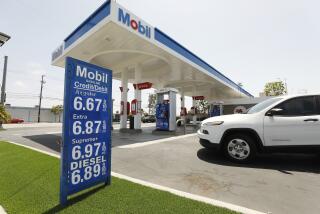Reagan Again Pushes Naval Oil Reserve Sale
- Share via
WASHINGTON — President Reagan is making one last stab at selling off the Naval Petroleum Reserve, telling Congress to unload it or else.
After eight years of trying unsuccessfully to persuade Congress that the government should get out of the oil business, Reagan in his final budget this week tied the sale of the reserves to the Strategic Petroleum Reserve.
“He is telling Congress that if they don’t sell (the Naval Petroleum Reserve), they had better find the money somewhere else to fill up the SPR,” said a congressional staffer.
The Reagan proposal will be endorsed by President-elect George Bush when he takes over later this month, Administration sources said.
The White House plan calls for the sale in fiscal year 1990 of the Naval Petroleum Reserves at Elk Hills, Calif., and Teapot Dome, Wyo., for a bonus payment of $1 billion. Under the proposed terms, the purchaser would be required to deliver 50,000 barrels per day for five years to the SPR salt domes along the Gulf Coast. Additionally, the buyer would also have to provide 10 million barrels of oil to a newly established Defense Petroleum Reserve.
Underground Caverns
“As a result of the sale, national preparedness will be enhanced due to the establishment of the Defense Petroleum Inventory and the increased oil provided for the strategic reserve,” according to Reagan’s budget message to Congress.
If Congress balks at selling off the naval reserves, so-called because they were established to keep Navy ships in fuel in case of emergencies, the SPR would be filled at a rate of only 22,000 barrels a day in fiscal 1990 under Reagan’s proposal since the Energy Department would be given only $127 million to spend for this purpose.
If Congress agrees to the sale, the fill rate would be 72,000 barrels per day, which would mean that the planned inventory of 750 million barrels would be reached early in fiscal year 1996, along with the ability to distribute 4.5 million barrels a day to the national pipeline system.
Started in 1975 as a hedge against supply disruptions, the six underground salt caverns along the Gulf Coast now hold some 550 million barrels. The Energy Department contracted with the Mexican state oil company, Pemex, to provide 78,000 barrels a day in fiscal year 1989 for about $242 million.
“We hope that this is much more palatable to Congress,” said Deputy Energy Secretary Joseph Salgado.
Asked why the outgoing Administration persists in trying to sell Congress on the idea after years of rejection, Salgado said: “It’s because we think it’s the right thing to do.”
The Reagan Administration from the start has wanted to sell the naval reserves, arguing that the private sector could operate it more efficiently and that it would help in reducing the budget deficit.
But Congress, backed by a reluctant Navy, has never warmed to the idea of selling off a national asset.
The incoming Bush Administration agrees with the sale proposal, transition team officials say, so it could become an issue in the new Congress.
‘Barter System’
“They have improved the salability,” said a House staff member who has tracked the proposal for the past eight years. “For years, the objections to selling it off has been mainly that you should not unload something without replacing it with something of value.
“They have dropped the idea of just getting some cash and gone back to the barter system,” he said. “It’s a creative move and if Bush really pushes it, it just might work.”
But Administration officials say that even if Congress approves the sale, it would take some time before oil companies would be able to bid on it.
The General Accounting Office, the congressional watchdog agency, studied the issue and said a major problem in putting the reserves on the market is that the government has no solid idea on how much oil is in the ground, an essential point in any planned sale.
Production at both Elk Hills and Teapot Dome is about 50,000 barrels per day combined but could be raised to about 100,000 barrels per day, government officials say.
More to Read
Sign up for Essential California
The most important California stories and recommendations in your inbox every morning.
You may occasionally receive promotional content from the Los Angeles Times.









